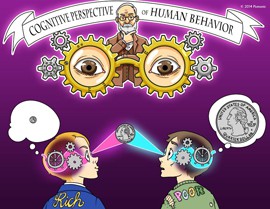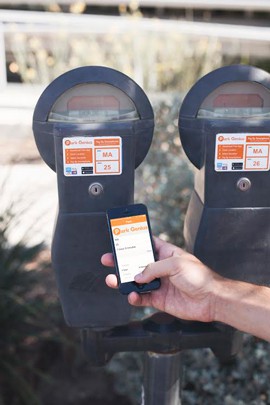- Slug: BIZ-Venture Madness, 1200 words
- Photos available (thumbnails, caption below)
By MERYL FISHLER
Cronkite News
Several Arizona startups have developed ways to make your life easier.
They want to give you the ability to tip through your smartphone, create a full-blown advertisement on your mobile device and pay for a parking meter with the press of a button.
The entrepreneurs behind these ideas are competing in Venture Madness, a bracket-style head-to-head competition between startups battling for their share of $50,000.
The second round is under way, with 32 of the original 64 startup companies vying to advance to the live-demo portion held in March.
Beyond the money, Venture Madness provides companies with vital exposure, said Jonathan Ariano, chairman of Invent Southwest, an Arizona-based organization that connects investors with ventures in the region.
“It gets a lot of people focused to review the company, team, business model and plan,” he said.
Invest Southwest, in partnership with the Arizona Commerce Authority, hosts the event, which supports talented entrepreneurs in the Southwest, Ariano said.
He said it also highlights the region as an expanding epicenter for new business success.
“The Southwest is becoming a new hub for startup ventures,” he said.
These startups are looking to follow in the footsteps of other Arizona success stories. One of the most well-known, high-achievement companies in Arizona is Scottsdale-based GoDaddy.
“We need more big wins under the belt from companies born and raised here,” said Dan Roberts, vice president of growth at Phoenix-based startup Tip.ly.
Ross Shaken, co-founder of Venture Madness competitor Park Genius, said he thinks “in a couple years, the Phoenix area will be a staple in the startup world.”
Here are five Arizona technology-based startups looking to gain traction from Venture Madness.
Picmonic:
Medical students Ron Robertson and Adeel Yang needed to retain vast amounts of medical knowledge while studying at the University of Arizona.
“Out of desperation, we started creating stories in pictures to remember better,” Yang said.
They found their drawings effective and created Picmonic. They worked with professional artists, graphic designers and software engineers to build the interactive learning system for nursing, medical and MCAT students.
The Tempe-based company allows users to look at audiovisual flashcards designed to improve memory retention. Yang said the company commissioned a study, which indicated the picmonics increase memorization capacity and improve long-term recall of information by joining humor and graphics.
Picnomic won the Arizona Innovation Challenge, hosted by the Arizona Commerce Authority and became participants of Venture Madness.
Tip.ly:
The app uses photos and location-based technology to allow users to tip in an increasingly cash-free world.
It applies in certain situations, like tipping a valet or bellhop, when you may not have cash and it’s not possible to tip with a credit card.
Co-founders Stephan Campbell and Tim Baldwin developed the app, which pairs peer-to-peer money transfers with facial recognition.
Tip.ly isn’t designed for sending money to friends, like apps Venmo and Square Cash. The facial-recognition feature exists so the recipient’s personal information, like an email address or phone number, remains private, just like in a cash exchange.
The recipient must register his or her photo on the company’s website if he or she doesn’t have an account. But if both parties have a tip.ly account, the app uses location-based technologies to match users.
The company’s greatest competition?
“Cold hard cash,” said Dan Roberts, vice president of growth.
But Roberts said the app is just as fast as a cash exchange and keeps the transactions private.
GLYTR:
This Phoenix-based startup wants people to have the capability to create online content with their phone.
GLYTR, which stands for “Give Life To Your Reality,” allows users to create quick multimedia web pages embedded with text, photo, video and audio recordings all from a mobile device.
Dr. Subrahmanyan Sudhakar, founder and CEO of GLYTR, said they wanted help people make a quick impact with their web pages, but wanted to do more than just provide text.
“A picture is much more powerful if you add a voice,” he said. “And with video, you get the full dimension.”
Sudhakar said it only takes five minutes to set up a GLTYR page that users can share via social media or email. The primary target of the subscription-based app is small businesses and professionals.
Any remotely tech savvy person could use GLTYR and create a multimedia page that includes advertisements, he said.
Crowd Mics:
Two years ago, co-founders and brothers Tim and Sean Holladay attended a meeting with about 120 people, but they couldn’t hear other people in the crowd.
“Why can’t I use my phone as a microphone if I can use it to talk to people around the world?” Tim asked.
Crowd Mics can turn an audience member’s iOS or Android device into wireless microphones by communicating via Wi-Fi with the presenter’s smartphone or tablet, which is connected to the venue’s audio system. Crowd Mics also includes a text comment and polling feature.
Crowd Mics is “the first downloadable mic for live events,” Tim said.
Crowd Mics is free for the audience, and the presenter pays based on the size of the event. The fee is $1 per person.
Park Genius:
Three University of Arizona graduates annoyed by coin-only parking meters developed an app that allows users to pay for meters remotely.
Other cities across the nation offer other parking payment apps, but Park Genius also works with older coin-only meters by using unique parking-space identifiers. Parking officers can access a database showing time purchased.
Local businesses also can advertise for specific events and promotions through the app, and merchants can provide parking validation through coupon codes.
The app is up and running in Tucson, and founders Ross Shanken, Thomas Maguire and Austin Weiss, plan to launch in El Paso, Texas, in the next couple of months. Last year, the trio made it to the Top 16 of Venture Madness, and they hope to make it all the way this year.
^___=
SIDEBAR:
Venture Madness
What: Live demo portion of Venture Madness.
When: March 4-6.
Where: Talking Stick Resort, 9800 E. Indian Bend Road in Scottsdale.
What: Final 16 compete for their share of $50,000 in cash prizes by live-pitching their way through the brackets before a panel of judges.
Details: www.venturemadness.com.

Medical students at the University of Arizona found drawings helped them retain information and created Picmonic. They work with professional artists, graphic designers and software engineers to build the interactive learning system. (Picmonic photo)

Photos and location-based technology work together to help people tip in an increasingly cash-free world. The app pairs peer-to-peer money transfers with facial recognition when you do not have cash, and credit-card tipping isn’t an option. (Tip.ly photo)

GLYTR is a mobile app that allows users to create quick multimedia web pages with text, photo, video and audio recordings – all from a mobile device.
(GLYTR photo)

Crowd Mics can turn an audience member’s iOS or Android device into a wireless microphone. The audience can talk into smartphones and tablets and be heard on the room’s sound system.
(Crowd Mics photo)

Three University of Arizona graduates annoyed with coin-only parking meters developed Park Genius, which allows motorists to pay for parking meters remotely.
(Park Genius photo)